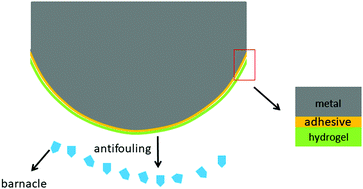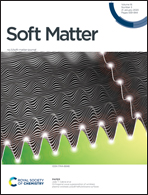Strong adhesion of poly(vinyl alcohol)–glycerol hydrogels onto metal substrates for marine antifouling applications†
Abstract
Hydrogels can be used as an alternative coating material for ships against marine biofouling. However, the adhesion of wet and soft hydrogels onto solid metals remains a challenging problem. Here we report the adhesion of a typical hydrogel material, poly(vinyl alcohol) (PVA)–glycerol hydrogel, onto stainless steel substrates and the antifouling potency of the adhered PVA–glycerol hydrogels. Poly(allylamine hydrochloride) (PAH) hydrogel and ethyl α-cyanoacrylate (ECA) are used as the binders, and they are found to be able to firmly bond the PVA–glycerol hydrogels onto the stainless steel substrates. The PAH hydrogel does not affect the mechanical properties of the PVA–glycerol hydrogel during use, but it tends to lose the adhesive ability in a dehydrating environment. In contrast, the ECA adhesive can maintain strong bonding between PVA–glycerol hydrogels and substrates upon several water losing/water absorbing cycles, despite some negative effects on the strength of the PVA–glycerol hydrogel. Biological experiments show that the PVA–glycerol hydrogel has a strong settlement-inhibiting effect on the barnacle Balanus albicostatus, suggesting that combining the PVA–glycerol hydrogel with ECA adhesive may have promising applications in marine antifouling.



 Please wait while we load your content...
Please wait while we load your content...